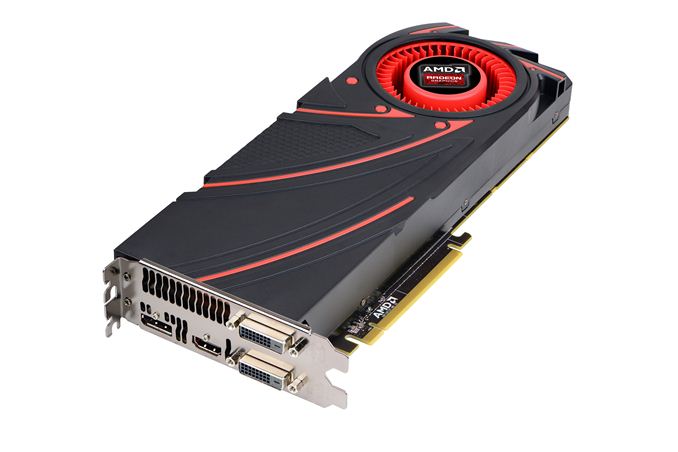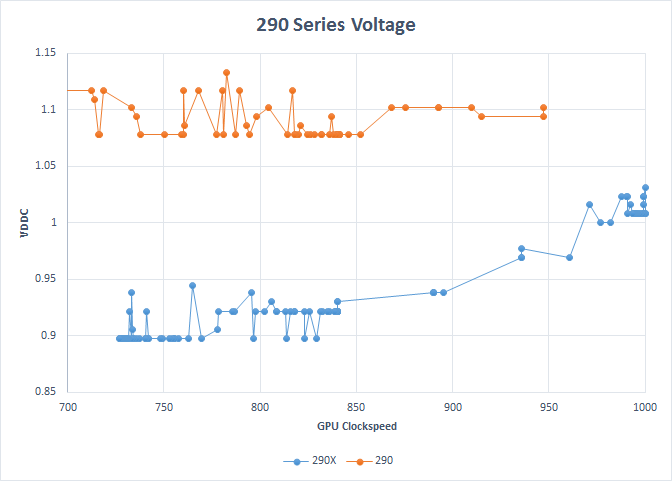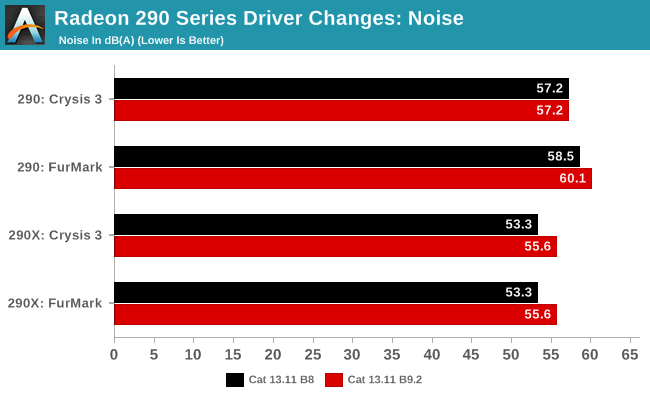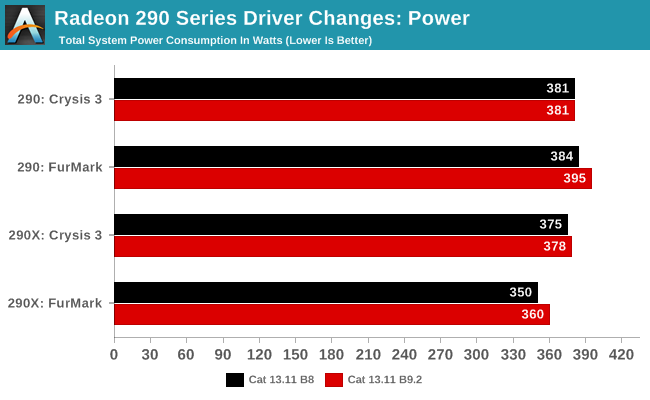AMD Changes 290 Series Fan Algorithms & About That 290 Conclusion
by Ryan Smith on November 9, 2013 3:48 PM EST- Posted in
- GPUs
- AMD
- Radeon
- Radeon 200

In a busy week that’s going to end up being just a bit busier, AMD has pushed out another Catalyst driver update specifically targeted at the new Radeon R9 290 series, Catalyst 13.11 Beta9.2. This release is especially notable because it resolves some outstanding issues with the hardware that the hardware press has covered in depth this week opposite the 290 launch, and because it is making low level operational changes that will have a direct impact on the power, noise, and performance characteristics of the 290 series.
First off, let’s talk about what AMD has done with their drivers. Citing an issue with variability in the fan speeds on 290 series cards, AMD has changed the algorithms for how their drivers handle the fan speeds on 290 series cards, essentially overriding the BIOS defaults with new values. This is similar to how AMD deployed their specification changes for the 290 ahead of its launch – adjusting it from 40% to 47% as the default maximum fan speed – but AMD has also used their driver update to change how they’re defining and controlling fan speeds.
Rather than controlling fan speed based on percentages, which are really measuring fan speed as the duty cycle of the fan’s motor on a relative basis, AMD has switched to controlling fan speeds on an absolute basis, using the measured RPM of the fan as their metric of absolute fan speed. This goes back to AMD’s concern over variance, as there is going to be some variance – and apparently too much variance – from fan motor to fan motor in how fast it can go, and consequently just what a specific duty cycle represents on a relative basis. Consequently by switching to measuring fan speed on an absolute basis there will definitely be less variation. as AMD is now controlling fan speeds by the very same metric they use to define that variation (RPM).
For the release of this driver, this is what AMD specifically had to say.
We’ve identified that there’s variability in fan speeds across AMD R9 290 series boards. This variability in fan speed translates into variability of the cooling capacity of the fan-sink.
The flexibility of AMD PowerTune technology enables us to correct this variability in a driver update. This update will normalize the fan RPMs to the correct values.
Given the significant interest there has been this week in articles published over at Tom’s Hardware and their experience with additional retail 290 series cards, it's likely that this is related to the issues Tom’s was seeing. In which case the implication is that fans are running too slow, which could've definitely resulted in lower performing cards. It's obviously also possible that fans could be running too fast in some configurations, which would obviously result in louder/higher performing cards. The third scenario that this update corrects is one that AMD told us about: where the fans are running too slow during light-to-medium workloads, which in turn allows the GPU to heat up more than it should and forces the fan to run at higher speeds down the line. In this third scenario, the overall acoustic profile of the card would actually be quieter post update. Admittedly this isn't something we test for or something we've seen internally, but it's a situation that AMD says also improves with this update.
Along with reducing variation the net result of this driver as far as our samples are concerned will be that fan speeds are going to go up. AMD’s new maximum fan speeds for the 290X (quiet mode) and 290 will be 2200RPM and 2650RPM respectively. A quick meta-analysis doesn’t show any site as having reported their review samples as having RPMs that high or higher, in which case the situation should be similar to ours. Our cards topped out at 2100RPM for the 290X and 2500RPM for the 290, so these new values represent a 100RPM and 150RPM increase in default fan speeds respectively. Or on a percentage basis, we’ve gone from 40% to 42% for the 290X, and 47% to 49% for the 290.
| AMD Radeon R9 290 Series Maximum Fan Speeds | |||||||||||
| Card | Catalyst 13.11 Beta 8 | Catalyst 13.11 Beta 9.2 | |||||||||
| 290X (Quiet Mode) | ~2100 RPM (40%) | ~2200RPM (42%) | |||||||||
| 290 | ~2500 RPM (47%) | ~2650 RPM (49%) | |||||||||
Since we don’t have any other 290 cards at this time, and our second 290X already behaved virtually identical to our first, we’re not in a position to talk about the matter of variance in further detail. Presumably variance was a big enough issue that it required AMD’s quick attention, but we don’t have any further cards to get a first-hand impression of just how large that variance was. Whatever the variance was though, this should virtually eliminate it.
What we can briefly look at however is how this changed our performance results. The net effect of this change is that AMD has increased their fan speeds for the 290 series, and as a result noise levels are going to go up slightly, and due to the close relationship between noise, cooling, and heat dissipation, power consumption will also go up slightly too. We’d say performance is going to go up too (again similar to the 290’s spec change), but in reality the amount of variance caused by PowerTune has all but drowned out any possible performance difference on our 290X. Meanwhile our 290 wasn’t cooling limited in the first place, so this change hasn’t affected gaming performance.
With respect to PowerTune on the 290X, we’ve been finding that PowerTune adjusts clockspeeds rather significantly in response to the smallest input changes, which makes it difficult to isolate any resulting performance changes from the fan speed adjustment. The reason why this is happening is unclear, but we suspect that it has to do with the 290 series cards not having much flexibility to adjust their voltages, resulting in them having to instead widely adjust their clockspeeds to achieve the necessary reduction in power consumption and heat generation.
To put this concept to the test, here are some quick scatter plots of the 290 and 290X running FurMark, plotting clockspeed against voltage (VDDC) as measured by GPU-Z. These voltages are going to be subject to external factors such as vDroop, but it’s the best we have right now since we can’t see VIDs.

In brief, there’s only roughly a 100mv difference in voltages between the 290X’s base clockspeed and boost clockspeed, and even less a difference on the 290. If this data is reasonably accurate, then it would explain why the 290 series sees such heavy clockspeed throttling at times, and why our gaming performance hasn’t changed. So with that in mind, let’s look at the numbers.

First and foremost, noise under load has predictably gone up. For the 290X where FurMark and Crysis 3 top out at the same point, this new noise level is 55.6dB, 2.3dB higher than the old maximum of 53.3dB. For the 290 on the other hand, noise levels don’t change under Crysis 3 since it wasn’t cooling/fan limited in the first place, remaining at 57.2dB. However the worst case scenario, as represented by FurMark, sees noise levels increase a further 1.6dB to 60.1dB.

As for power consumption, since we’re clearly cooling limited in most scenarios on the 290 series, any increase in cooling performance causes an increase in power consumption. For the 290X in FurMark this is another 10W at the wall, while under Crysis 3 (where performance is nearly identical) this is a barely measurable 3W difference. While for the 290 the difference is 11W for FurMark, and absolutely nothing for Crysis 3 since it wasn’t cooling limited in the first place.

Finally for performance, we can see that the fan speed adjustments had no measurable impact on performance under Crysis. The 290 was never cooling limited in the first place, and for the voltage issues discussed further, PowerTune has all but wiped out any potential performance improvement for the 290X, leaving it changed by a fraction of a frame per second. Unfortunately this means the noise increase is very real, but there’s not a measurable performance increase to go with it.
With all of that said, this won’t be impacting our reviews of the 290 or 290X (or GTX 780 Ti), as there isn’t a performance change to account for, and the noise change, though unfortunate, is under gaming workloads limited to the 290X (though this does mean 290X loses some further ground to 290).
About that 290 Conclusion
Since we’re already on the matter of our recommendations, I wanted to spend a bit of time following up on our 290 review, as that review and its conclusion generated a lot more feedback than we had been expecting. In this week’s article I flat out avoided recommending the 290 because of its acoustic profile. When faced with the tradeoff of noise vs. performance, AMD clearly chose the latter and ended up with a card that delivers a ridiculous amount of performance for $399 but exceeds our ideas of comfortable noise levels in doing so.
I personally value acoustics very highly and stand by my original position that the reference R9 290 is too loud. When I game I use open back headphones so I can listen for phone calls or the door for shipments, and as a result acoustics do matter to me. In the review I assumed everyone else valued acoustics at least similarly to me, but based on your reaction it looks like I was mistaken. While a good number of AnandTech readers agreed the R9 290 was too loud, an equally important section of the audience felt that the performance delivered was more than enough to offset the loud cooling solution. We want our conclusions to not only be reflective of our own data, but also be useful to all segments of our audience. In the case of the 290 review, I believe we accomplished the former but let some of you down with the latter.
Part of my motivation here is to make sure that we send the right message to AMD that we don’t want louder cards. I believe that message has been received loud and clear from what I understand. It’s very important to me that we don’t send the message to AMD or NVIDIA that it’s ok to engage in a loudness war in the pursuit of performance; we have seen a lot of progress in acoustics and cooler quality since the mid-to-late 2000’s, and we’d hate to see that progress regressed on. A good solution delivers both performance and great user experience, and I do believe it’s important that we argue for both (which is why we include performance, power and noise level data in our reviews).
The Radeon R9 290 does offer a tremendous value, and if you’re a gamer that can isolate yourself from the card’s acoustics (or otherwise don’t care) it’s easily the best buy at $399. If acoustics are important to you, then you’re in a tougher position today. There really isn’t an alternative if you want R9 290 performance at the same price. The best recommendation I have there is to either pony up more cash for a quieter card, accept the noise as is or wait and see what some of the customized partner 290 cards look like once those do arrive. I suspect we’ll have an answer to that problem in the not too distant future as well.
Note that this isn't going to be the last time performance vs. acoustics are going to be a tradeoff. AMD pointed out to us that the 290/290X update is the first time its fan speed has been determined by targeting RPMs vs. PWM manipulation. In the past, it didn't really matter since performance didn't scale all that much with fan speed. Given the current realities of semiconductor design and manufacturing, the 290/290X situation where fan speed significantly impacts performance is going to continue to be the case going forward. We've already made the case to AMD for better reference cooling designs and it sounds like everyone is on the same page there.
Given the amount of interest this has generated I'm curious to get your feedback on the performance vs. acoustic debate. Feel free to share your comments below on how important acoustics are for you (vs. performance) and at what point does a GPU become too loud? For us the reference point was NVIDIA's GeForce GTX 480, but I'm interested to know what GPUs in your past have been too loud.










141 Comments
View All Comments
nevertell - Saturday, November 9, 2013 - link
As I already commented on the original review, nobody has a problem with acoustics when AMD does this, when the 480gtx came out, everyone had a rather strong opinion that the card was ridiculous. Of course, AMD has the value argument on their side, which nvidia rarely has.krumme - Saturday, November 9, 2013 - link
First off all. Thanx for the update.If the result for this is amd abandons bad blowers its super. Its about time.
If the result is users losing an ability to flip a switch and change profile to their personal preferences its a loss.
If the result is nv or amd beeing more carefull about using new technologies to controll power to maximize performance instead of a fixed core freq its a loss.
I know noise is personal. I own a very silent card that most can not even hear in idle. I unplug it entirely when i dont game. My dishwasher is the most silent on the market. My car is silent.
I want everything silent except myself.
Take care
frogger4 - Saturday, November 9, 2013 - link
I simply don't buy anything that doesn't have an open-air cooler now. I used to have a reference HD 6970, and that was simply too loud for me. It was so bad (in my opinion) that I modded it with an Arctic accelero cooler, and was really happy with it after that. I understand the argument that open air coolers spill hot air into the chassis, but that has been a complete non-issue. A chassis with good airflow and a graphics card with the largest open-air cooler you can get has proven to be a very good solution to me.I say all of this to make this point: I'm not concerned about how loud a reference blower card is, since I would always buy one with a much quieter custom cooler.
dylan522p - Saturday, November 9, 2013 - link
Blower cards can be good if done right.Impulses - Saturday, November 9, 2013 - link
Possibly, but it seems open air coolers always have much more potential... It's kind of natural after all, how do most enthusiasts cool their CPU? Big open air tower cooler. I don't see why we should favor blowers just to make up for bad PC cases.zanon - Saturday, November 9, 2013 - link
Ryan, I'm glad you're soliciting feedback like this, it's noted and appreciated. With regards to the importance of acoustics, I think you'll find two major camps which diverge pretty heavily. Prefacing with a few points, obviously there will be *some* simple, raw noise level at which point it's unacceptable to anyone with hearing, the sort of profile sometimes found in components designed 100% purely for datacenter/industrial use with no humans around (or at least no humans not equipped with high grade ear protection). Also, I don't think you've formally designed a test for this yet, but it's worth noting too that the quality of the noise matters, not merely the decibels. Certain types of whines, high pitches, patterns, and so on can be vastly more annoying even at a low level then simple white noise, and decibel level alone wouldn't necessarily capture that. So with that aside:First camp is clearly what you fall into: users who are interested in primarily stock usage with speakers or open backed headphones, and/or in an environment with others around, for whom total system acoustics is a really, really important consideration. If it's loud to any real degree then it could range from immersion breaking to flat-out useless.
Second camp though consists of both users who go heavily custom or those like me with higher environmental tolerances. WRT the first, let's be honest: even though $400 isn't super ultra highest end, and even when the performance is really, really a good value, it's still a really rarified and self-selected market. While the average person never thinks about custom loops or third-party coolers or whatever, a buyer of a $350+ card, any $350+ card, is not the average person and I suspect there is a vastly higher incidence of customization there. For those users a good water loop for example can handle pretty much any level of heat and can do so quite quietly with the right components, so the real limiting factor is whatever limits the silicon itself has. A really solid card with a crap reference cooler they'd never use anyway is perfect. Also, while this is more the future don't forget about newer cable standards: with the kind of range we're going to be able to get from stuff like optical TB, it'll become more practical to have a system in a completely different place from the desk.
To the second I'll use myself as an example. My own computerspace is physically isolated, and while I have a decent sound system I'm using IEMs (Shure SE535s), which have a key selling point of great passive isolation. My phone calls are VoIP so my system alerts me and I can reply without taking them off, I don't get many deliveries but I've been working on wiring that to my LAN too. So it simply takes a comparitively much higher level of noise before I can even hear it, let alone care. All else being equal I'd pick a quieter system, and I definitely care about the noise profile, but the balance of accousts/performance will tend to weight more heavily towards the latter, that's one of the balances of my own use habits.
So I agree with you wanting to encourage AMD and Nvidia in particularly to keep a lid on noise, but at the high-end enthusiast level there certainly appears to be a significant group with different tolerances, either because of how they work or because of how they customize and build or both.
jenneth - Saturday, November 9, 2013 - link
"While the average person never thinks about custom loops or third-party coolers or whatever, a buyer of a $350+ card, any $350+ card, is not the average person and I suspect there is a vastly higher incidence of customization there."But that's purely a speculation on your part though. I generally spend more than $400 on video cards (though I usually upgrade once every three years or so) and I've never thought about water cooling. Furthermore, for people who have a decent audio system, noise do matter.
zanon - Saturday, November 9, 2013 - link
>But that's purely a speculation on your part though.No, it's not pure speculation. The objective fact is that products are being offered, which in turn means there is a market. Those companies aren't charities, if there was no money to be made the products would not last, but they have. Going by general trends period as well as normal economic logic, extrapolating that most of that sort of thing is going to the high end is not much of a stretch. If you want to argue though that 3rd party coolers, full loops and so on are being bought by people who get $100 cards then go for it.
>Furthermore, for people who have a decent audio system, noise do matter.
As I said, this is not necessarily true. Next time try reading the whole thing before responding. IEMs are absolutely "decent" or beyond decent, even before getting into $1000+ full custom plugs. A decent input source like an O2+ODAC and a set of good IEMs will be competitive with any headset on the market. Whether you want significant isolation or not and whether you like something in your ears or not is a matter of personal preference, but the fact remains that a significant number of people use an audio setup where room noise is massively reduced, with all the pluses and minuses that entails.
jenneth - Saturday, November 9, 2013 - link
>>No, it's not pure speculation.Again, you offer no solid facts to support your argument. In your original post you made it sound like $350+ video cards are ultra highend and are out of reach for the 'casual gamers.' That's my problem with your argument.
>>A decent input source like an O2+ODAC and a set of good IEMs will be competitive with any >>headset on the market.
I have a Sennheiser HD800 (which is an 'open' headphone), along with Luxman P-1u and PS Audio Perfectwave DAC (I usually do switch to Xonar STX for gaming though), so I have a fairly decent system, and yes, I do game on that system.
zanon - Sunday, November 10, 2013 - link
>Again, you offer no solid facts to support your argument.Again, you completely ignore it all. However, if you want solid numbers then we can do that too.
>In your original post you made it sound like $350+ video cards are ultra highend and are out of reach for the 'casual gamers.'
They are, and if you think otherwise then you really, REALLY need to get out of your bubble. For hard numbers we now have a really massive, wide based one: the Steam Hardware Survey (found here: http://store.steampowered.com/hwsurvey). Go take a look at it, I don't think a lot of the type who would visit Anandtech at all have any idea exactly how out there they are. Of Steam's userbase, nearly TEN PERCENT is on INTEGRATED GRAPHICS. And not new Iris stuff either, but horrible old HD 3000/4000 crap. Look for $350-400+ cards (new, some of what we see there might be used/clearance if it's not current gen). You have to go down 7 places to find the GTX 670, at 1.48%. The next one, the 680, is another 16 places down at 1.09%, and it's all downhill from there. The 570 1.04%, the 580 is 0.72%, the 770 clocks in at a glorious 0.60%, and the 780 is too small to even make the top 60. AMD does even worse.
That is the reality: maybe 6-7% of the PC gaming market goes for these total, and an even tinier fraction are getting them within a generation of release.
>so I have a fairly decent system, and yes, I do game on that system.
I'm not sure what your point is with this. Of course open systems, or speakers, can be good also. That's what Ryan is using too. But you asserted that any "decent audio system" was very sensitive to noise, which is wrong.